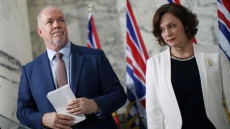A long-awaited legal look into whether the U.S. remains a safe country for refugees begins today at a Federal Court in Toronto.
At issue is an international agreement that prohibits people from crossing into Canada from the United States at formal crossings and asking for asylum.
The Safe Third Country Agreement was signed 17 years ago by Canada and the U.S., but recently has come under intense scrutiny as the U.S. has tightened its asylum rules and regulations.
Refugee advocacy groups say the new American regime effectively cancels out the idea that the U.S. is safe for refugees, and therefore the agreement violates people's charter and other rights.
The case was launched in 2017 after a Salvadoran woman tried to enter Canada at an official border crossing to ask for asylum, and was told she was inadmissible because of the deal.
In their filings, the federal government argues the U.S. asylum system still functions with checks and balances that provide adequate protection.
A timeline of the issues around the Safe Third Country Agreement
OTTAWA - The long-awaited legal challenge over whether a deal between Canada and the U.S. governing refugee claims violates the Canadian Charter of Rights and Freedoms began today at Federal Court in Toronto.
Here's a timeline around the Safe Third Country Agreement (STCA) and the issues it has sparked in Canada.
2002: Canada and the U.S. sign the STCA. Its goal is to "manage the flow of refugee claimants." It acknowledges that both countries offer substantial refugee protections and, therefore, asylum seekers can't arrive in Canada and then file claims in the U.S., or vice versa — they have to seek sanctuary where they first arrive, with some exceptions. But the deal only applies at formal land, sea or air crossings.
2004: The STCA comes into effect.
2007: A judicial review of the STCA is launched before the Federal Court by the Canadian Council for Refugees, Amnesty International Canada, the Canadian Council of Churches, and John Doe, an anonymous refugee claimant in the U.S. who claimed that if it weren't for the deal, he would have applied for refugee status in Canada. The Federal Court rules the U.S. refugee record at the time did not meet Canadian requirements, and the designation of the U.S. as a safe country was unreasonable. The decision was overturned on appeal for technical reasons.
2016:
April: Canada Border Services Agency and the RCMP begin noticing an increase in the number of people coming into Canada at unofficial border crossings, expressly for the purpose of claiming asylum.
November: Donald Trump is elected as president of the United States, with immigration reform — including a crackdown on immigrants and refugee seekers — one of his key promises.
December: National attention focuses on Emerson, Man., a small town not far from the U.S. border, where asylum seekers are crossing into Canada in frigid winter conditions. Calls begin for Canada to address the STCA, with advocates pointing out that people are crossing irregularly in order to get around the deal: they can file refugee claims in Canada as long as they don't enter from the U.S. using a formal border point.
2017:
January:
— Trump issues one of his first executive orders as president. Best known as the "Muslim ban," it barred entry to the U.S. for people from certain countries. But it also lowered the number of refugees to be admitted to the U.S., suspended the refugee admissions program for three months and suspend the acceptance of Syrian refugees indefinitely. Protests broke out immediately, including chaos at airports as travellers were detained and visas revoked. The order would be challenged in court.
— Calls immediately emerge for Canada to suspend the STCA. Federal government says it is monitoring situation.
— Prime Minister Justin Trudeau posts a message on Twitter seen as a response to Trump's decision: "To those fleeing persecution, terror and war, Canadians will welcome you, regardless of your faith. Diversity is our strength.”
— Border crossers in Manitoba report they are fleeing the U.S. over concerns about American immigration policy.
March:
— Federal government prepares for a possible surge of border crossers, as numbers rise not just in Manitoba but in Quebec and Ontario.
— The Liberal cabinet begins mapping out strategies and contingency plans, including the use of the military and empty government buildings to house and process incoming refugee claimants.
— Immigration Minister Ahmed Hussen tells MPs that political instability in the U.S. is not necessarily the main driver of asylum seekers, noting that many who crossed into Manitoba had actually been in the U.S. less than two months.
June:
— A surge in asylum seekers crossing into Quebec on what's known as Roxham Road begins.
July:
— Nearly 3,000 people are intercepted in Quebec alone as number of asylum seekers continues to rise.
— The Canadian Council for Refugees, Amnesty International and the Canadian Council of Churches announce they will again attempt to challenge the legality of the STCA in Federal Court. They are joined by an individual called "E," a Salvadoran woman who fled her home over fears of gang violence but was turned away from Canada because she tried to file a refuges claim at a formal border crossing. She believes she will not receive refugee protection in the U.S.
August:
— Federal government announces an "ad hoc intergovernmental task force on irregular migration" tasked with managing the asylum seeker influx. It includes provincial representation.
— Members of Parliament from Spanish and Haitian backgrounds are sent to the U.S. to try and dissuade people from coming to Canada through unofficial border points, amid fear of misinformation campaigns circulating in the U.S. that are encouraging people to come north.
December: In all of 2017, 20,593 people are apprehended by the RCMP crossing into Canada between official ports of entry.
2018:
February:
— Federal budget sets aside close to $200 million over two years to deal with processing of asylum claims.
— Trump administration begins practice of separating minors from their families at the U.S.-Mexico border, drawing international condemnation.
July:
— Former Toronto top cop Bill Blair given new cabinet portfolio with responsibility for border security, which will handle asylum seeker issue.
— Parties in Federal Court case file flurry of evidence, pointing to recent changes in U.S. law — including the end of people being able to claim domestic violence as grounds for asylum — as more evidence U.S. no longer safe for refugees. The applicants argue "returning refugee claimants to the U.S. and exposing them there to a serious risk of arbitrary, lengthy detention and refoulment (deportation), Canada violates their charter rights."
December: 19,419 people are apprehended by the RCMP between ports of entry for all of 2018.
2019:
March:
— Blair says he is talking with U.S. about closing the loophole in the STCA.
— Federal budget invests $1.18 billion over 5 years, starting in 2019-20, and $55 million per year thereafter to "enhance the integrity of Canada’s borders, and to process an increased number of asylum claims in a timely manner."
July: American decision to severely restrict refugee claims from those who cross into the country via Mexico again sparks demand for Canada to amend or suspend the STCA. Federal government continues to say it stands by the definition of the U.S. as a "safe country" for refugees.
October: Liberals are elected to a minority government. Platform promises effort to "modernize" STCA.
November: Federal Court hearing begins.


